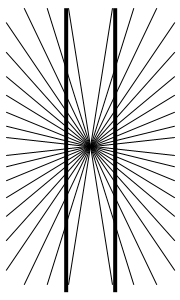Herring illusion

The Herring illusion is a distortion illusion first published in 1861 by the German psychologist Ewald Herring (1834–1918), and now named after him. As in the case of the Zöllner illusion and others, it shows how geometrical relationships can seem to be distorted by their background (a lined background can make circles, squares, and triangles seem distorted too). The parallel lines in the illusion appear to bow out in the center. This can be explained if the brain interprets the radiating lines in terms of depth, making the central spot in the Herring diagram, and thus also the heavy black lines near the center of the diagram, appear to be further away than the edges. Because the heavy black lines are the same thickness at the center as at the edges but are assumed to be further away, the brain thinks they must be more widely spaced at the center.


